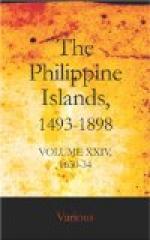A papal bull concerning missions is issued (June 28, 1633) by Urban viii. After citing previous decrees of the Holy See respecting the despatch of missionaries to Japan and the Philippines, and their journeys between those countries, Urban grants permission to the heads of religious orders to send missionaries to the countries and islands of Eastern India by other routes than that of Portugal. He also warns the religious thus sent to observe uniformity of instructions to the newly-converted heathen, “especially in matters relating to morals,” and “to restrict their teaching to general principles.” They must base their instruction on the Roman Catechism and Bellarmino’s “Christian Doctrine.” They are empowered to administer the sacraments to the Christians in Japan; and are strictly forbidden to engage in any form of trade, directly or indirectly. The superiors of orders are directed to enforce the penalties herein imposed on religious who may violate this prohibition; and disputes arising between orders are to be settled by the bishops of the respective countries, who are also directed to enforce the observance of these decrees.
A Dominican at Manila, Juan Garcia, sends (1632) to Sevilla such news as he can gather soon after his arrival in the islands. In Japan, it is said, the emperor has imprisoned many Dutchmen; and, with the decline of their influence, he has become more lenient to the Christians, sending them into exile instead of putting them to death. But any friars or preachers captured there are horribly tortured. The Dominican mission to Camboja has been unsuccessful. Formosa is being conquered by soldiers, and Dominican friars are making some conversions there. Some of these preachers have gone to China, where the field is enormous, but full of promise.
Juan Cerezo de Salamanca, governor ad interim between Tavora and Corcuera, sends a report to the king (August 14, 1633). The first section relates to military affairs. The forts and troops in the islands are enumerated. It is somewhat doubtful whether the occupation of Formosa should be maintained. More care should be taken in sending reenforcements to Ternate, and Heredia should be superseded as governor. The galleys belonging to the government are useless, and Cerezo will dispense with all save that at Ternate. There is quarreling over the legal status of the army men in the courts, which should be defined.




